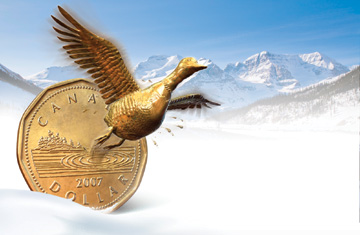
(2 of 2)
There was a downside, of course. Across from Detroit in Windsor, Ont. — at Canada's busiest border crossing — the plumped-up loonie did not bring such good humor. Windsor is one of the few urban centers in Canada — almost all of them in Ontario — where unemployment has risen since 2002. Gurmit Singh Bains drives his taxi along the riverside. "It's like a ghost town," he says. "The whole economy is down: hotels, restaurants, everything." The waterfront DaimlerChrysler Canada headquarters opened to much fanfare there in 2002, when the city's auto-manufacturing industry was red-hot. Today, the building's cavernous ground-floor retail space is almost empty. As the rising dollar made Canadian products more expensive around the world, Canada shed nearly 100,000 manufacturing jobs in 12 months. "We went from [being] the lowest-cost producer of vehicles around the world for GM, Ford and Chrysler to probably one of the highest," says Buzz Hargrove, president of the Canadian Auto Workers Union.
The bad news wasn't limited to manufacturing. Any firm that depends on U.S. customers felt the exchange-rate pinch in 2007. At tourist hubs like Niagara Falls and Whistler, businesses report fewer visitors. Americans made about half as many trips north in 2007 as they did in 2003. Natural-resource industries, for which prices haven't risen substantially, also suffered. "In the month of November there wasn't a single Canadian sawmill that made money," says Russ Taylor, president of forestry consultancy International Wood Markets Group. Nova Scotia's biggest Christmas-tree grower shipped a quarter of a million balsam firs this year, mostly to U.S. stores. Next year they're shutting up shop in Canada altogether, says Mac Kirk at Kirk Forest Products. The strong loonie eroded all their profits. "It is loony," Kirk says.
And how loony Canada became in 2007. Above all, it was a year of unpredictability. In October border waits were up to three and a half hours long. In Canada, there were reports of angry customers throwing books at store clerks, enraged by the stickers printed up months in advance that forced Canadians to pay up to 30% more than Americans for the same goods. On Nov. 7, the day the loonie reached $1.10 U.S., the currency's value swerved and swung over a three-cent range in a single day — a difference that for the Blue Jays, at least, means most of the annual salary for slugger Alex Rios. "Volatile," Bank of Canada governor-to-be Mark Carney calls the dollar fluctuations. No kidding.
Sooner or later the politicians were bound to weigh in. On Nov. 7, Stephen Harper announced he was "concerned" about the dollar's "unprecedented" rise, an unusual Prime Ministerial foray on to Bank of Canada turf. Ontario Premier Dalton McGuinty met with the PM the next day, calling for lower interest rates and a federal contribution to a $1.1 billion jobs fund for struggling Ontario manufacturers. (Harper made no promises.) The same day, the Quebec Premier was demanding a loonie summit with all the provincial Premiers. (One is now scheduled for January). Just six weeks after the loonie achieved parity with the buck in September, Canadians still seemed disconcerted, as if something a tad unnatural had happened.
Down to earth
It didn't last. In November, the great northern diver dipped again, bringing the dollar back below $1 U.S. Today, the major Canadian banks predict commodity prices will fall more as the U.S. economy cools, landing the loonie somewhere around 95 U.S. cents at the end of 2008. But few predict a return to the low, low loonie levels that Canadians knew just one year ago, and that means the structural shift in Canada's economy — with growing differences between sectors and between geographic regions — seems set to continue. "It's almost like a tale of two economies," says Douglas Porter, deputy chief economist at BMO Capital Markets, "and I think that stark divergence will continue in 2008."
No doubt that means there's more bad news ahead for Canadian pigs and good news for American lettuce. Still, despite the ups and downs the dollar brought in 2007, Canada's economy barely wavered. Along with the loonie, output, employment and Canadians' deservedly inflated pride all flew steadily in the face of a global credit crisis. In fact, the most remarkable thing about the loonie's ascent may be how handily Canadians handled it — notwithstanding the odd hurled book. Just imagine if in 2002 someone had prophesied today's exchange rates. "I think we [all] would have concluded that the Canadian economy would be decimated," says Don Drummond at TD. "We have thrived through this." It's a good thing, too. The loonie may be flying high for a long while to come.
